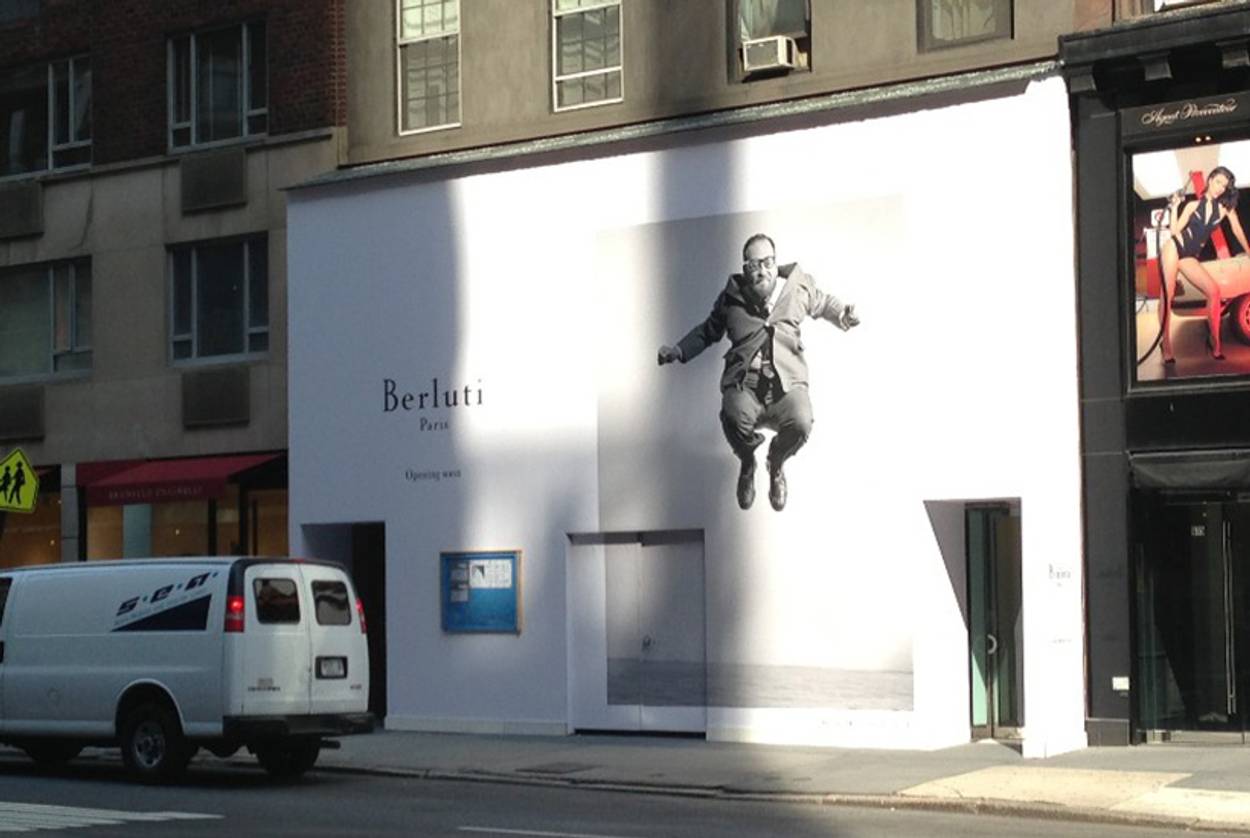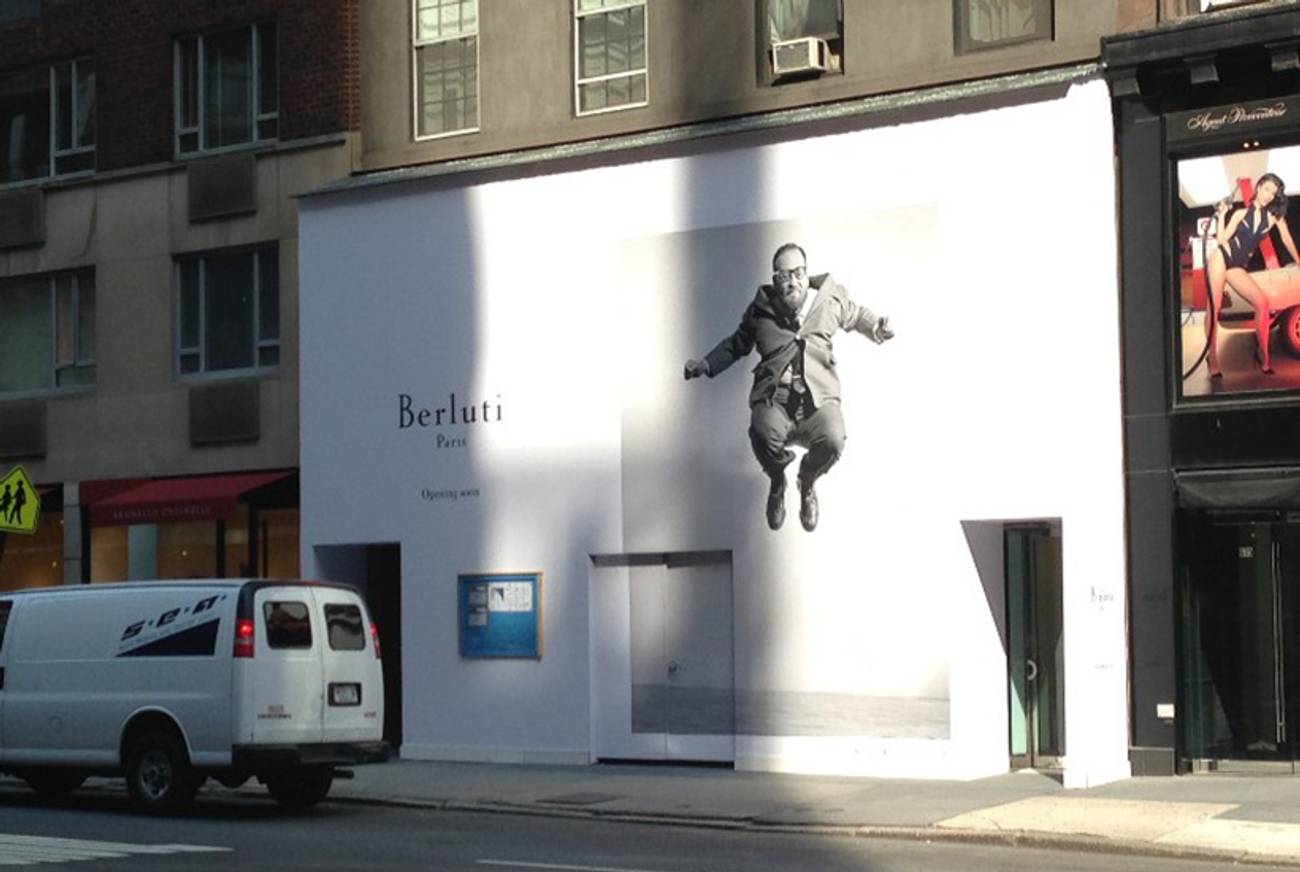How Stanley Edgar Hyman Jumped Into Madison Avenue Luxury
The late critic, my father, professor, and bon vivant is the unwitting star of a Berluti ad campaign




Millions of people venturing onto Madison Avenue in midtown Manhattan this past summer encountered a most improbable sight: a large billboard upon which a bespectacled middle-aged man from the Mad Men era is jumping straight up into the air for no apparent reason. It is Stanley Edgar Hyman—my father, erstwhile teacher, critic and staff writer for The New Yorker and The New Republic, and husband of my mother, novelist Shirley Jackson—pictured without explanation save a small credit by the Berluti boot company of Paris. Berluti has chosen to use the black-and-white image by the renowned photographer Philippe Halsman as the center of its marketing campaign this season, arranging framed posters of Hyman’s jump inside its fashionable stores. He does not even wear the brand; his shoes are his own off-shelf loafers.
Hyman, who wrote books, reviews, and criticism for three decades until his early death in 1970, would have turned 94 this June, and would no doubt be greatly amused by this current public display of his hidden athleticism. The sedentary scholar was born in Brooklyn in 1919, the first son of the children of immigrant Orthodox Jews from Russian Poland. He began writing in the early 1940s first at The New Republic and then emerged a few years later as the joke-telling, outspoken intellectual centerpiece of a group of writers at The New Yorker that included regulars Brendan Gill, Joseph Mitchell, Philip Hamburger, Jim Geraghty, and editor William Shawn. Outside the office their noisy gatherings in the Algonquin Hotel Lobby Bar and other local watering holes like the Red Devil, The Lobster, or Stouffer’s, would usually last well into the night, with Hyman almost always to be found talking loudly in the center.
Hyman is best known for his groundbreaking books on literary criticism, The Armed Vision, The Tangled Bank, and The Promised End. Those who still remember Stanley Edgar Hyman—and his name may still bring a chuckle to some old-timers in New York publishing and at Bennington College, where he taught for decades—likely picture a short, stocky, bearded intellectual who called himself a critic, sitting amidst a cloud of cigarette smoke and telling stories loudly to a group invariably gathered around him, often at his feet. He would grin, explode in laughter, gesticulate with both arms while telling stories in elaborate detail and with great relish, the dangling ash from his cigarette at last falling unnoticed onto his trousers.
People loved to hear him talk, and when he spoke of himself it was almost invariably with self-deprecation and mocking Jewish humor. So, it comes with great surprise now to see Hyman jumping with such innocent agility on posters inside Berluti stores and outside on billboards in New York, Paris, Hong Kong, and throughout Asia, and in an elegant photo-album-type greeting card mailed worldwide.
Jumping three feet straight into the air from a standing position would scarcely be what anyone might have thought him capable of (try it—it is hard), yet there he is—intense determination showing in his relaxed face, arms outstretched, eyes clenched shut behind thick black-framed glasses, feet tucked neatly underneath him, even holding a cigarette casually in his hand—with the floor, in focus, remaining many feet below him. The remarkable jump was caught in a still made in 1959.
Hyman was raised in Orthodox Judaism and led a pious childhood, sometimes even fainting from fasting. He attended the fiercely competitive P.S. 99 and a succession of Hebrew schools but resisted their rote instruction and corporal punishment. At Erasmus Hall High School in Brooklyn, where he developed a deep interest in journalism and theater, Hyman received excellent grades and developed rigorous work habits he would keep for the rest of his life.
Hyman attended Syracuse University in 1936 and studied with Leonard Brown, who later introduced him to Kenneth Burke, soon to become Hyman’s mentor and good friend. It was there that he met Shirley Jackson, a fellow sophomore, and together they founded and edited a literary magazine, Spectre. They each contributed many essays, stories, and poems. Before they both graduated in 1940 Hyman won The New Republic College Essay Contest, and he worked that summer in New York as editorial assistant. Hyman and Jackson married on Aug. 13. That winter Hyman became staff writer for The New Yorker and remained in that position for the rest of his life.
Hyman lived in Vermont with Jackson and us four children where his class “Myth, Ritual, and Literature,” was by far the most popular one at Bennington. He contributed most of his writing for the magazines by post, but he would occasionally commute by train from his home in North Bennington to Manhattan to visit the office and his friends, often accompanied by Jackson. Regarding the train a luxury, the Hymans would establish camp in the bar-car where Stanley would read the New York Times with furious concentration while Shirley would gaze out the windows, never tiring of the views during the five-hour trip along the Hudson River.
Gill later recalled in his book, Here at the New Yorker, that Stanley would arrive with what seemed like a magic briefcase, in that it would be stuffed with bottles of scotch and bourbon coming in, and no less a bulk and weight in New Yorker stationery going home. He would spend a few days at the office while Shirley would meet with her agent and friends, shop, and go to afternoon movies with Stanley’s mother. In the evenings, ensconced at the nearby Algonquin or Royalton Hotel, the Hymans would run a constant cocktail party in their room. Friends, other magazine staff, anyone the Hymans knew (or friends of theirs) was welcome to join the usually raucous debates in their smoky suite.
After The New Yorker published Jackson’s story “The Lottery”in 1948, the magazine received more mail in response to it than ever before or since. She had to go daily to collect piles of hate-mail at the local post office. Most readers were horrified, some canceled their subscriptions, and others wanted to know where the lotteries were held so they could go and watch. Many felt the story was about anti-Semitism and the Holocaust, but her response to all questions was that it was “just a story.” Some villagers thought it was about them and North Bennington, and soon public life in the small Vermont village began to lose its appeal for the literary couple. Stanley was also tiring of the long commute to the magazine’s offices and losing interest in teaching, and soon they moved to Saugatuck, Ct., outside Westport, to be nearer the city. Their house was often filled on weekends with visiting friends: artists, actors, poets, composers, other writers, former students, and it was here that Stanley continued to help his friend Ralph Ellison shape Invisible Man over the many months Ellison lived in their guest room. There were all-night poker games, rowdy softball games on their large front lawn on Sunday mornings, horseshoes and ping-pong tournaments, and long, heated evening discussions, often with Stanley’s beloved Brooklyn Dodgers playing in the background on their small black-and-white television. Decades later, Ellison still loved to tell the story of driving Shirley to the hospital—in a trip out of a movie chase scene—to deliver her fourth child in 1951 because only he was able to drive a car.
Soon Stanley was lured back to teaching at Bennington, and they moved to a succession of houses while each producing a number of books. Stanley wrote and edited several books of literary criticism following his initial 1948 volume, The Armed Vision: A Study in the Methods of Modern Literary Criticism, with its barbed instructions to a dozen of his contemporary critics. It was The Tangled Bank, his analysis of Darwin, Marx, Frazer, and Freud “as imaginative writers,” that required a jacket photograph, in 1959, and Stanley was sent by his publisher to Halsman’s studios in Manhattan.
Stanley loved to describe his portrait session with Halsman to friends, grinning as each detail was revealed. He would tell of arriving and seeing portraits of kings, presidents, and movie stars on the walls. Halsman arranged him in front of some books and a bust of Jefferson, and he sat for the photograph, his eyes looking away from the camera and puffing thoughtfully on a cigarette. Afterwards, Halsman showed Stanley his great work in progress—photographing his famous subjects jumping into the air, with a photographic technique he alone had developed, in his theory (“Jumpology”) that people’s true facial characteristics are revealed at the apex of their jump—and Stanley agreed to jump for him. Halsman sized him up, Stanley would chortle in the telling, and adjusted his lens and lights very low, believing that the portly gentleman might get off the ground an inch or two at best.
But the first exposure was of Stanley’s feet alone. He had flown into the air with such gusto, to such a height that the famous photographer was astonished. Halsman reset his equipment while Stanley lit another cigarette, and the celebrated jump was captured. But this time Stanley’s eyes were closed (the exposure Berluti is using in its campaign), and Halsman then asked the willing athlete to jump yet again. That image was later published in Jump Book. There he is, “Professor Stanley Hyman,” jumping gleefully, opposite no less than J. Robert Oppenheimer, and only pages from the Duke and Duchess of Windsor, Judge Learned Hand, and Richard M. Nixon, all of them likewise gamely airborne. But only Stanley is now leaping high above New York.
***
Like this article? Sign up for our Daily Digest to get Tablet Magazine’s new content in your inbox each morning.
Laurence Jackson Hyman is a jazz musician, editor, publisher, photographer, and former president of Woodford Press and Crescendo Studios.
Laurence Jackson Hyman is a jazz musician, editor, publisher, photographer, and former president of Woodford Press and Crescendo Studios.